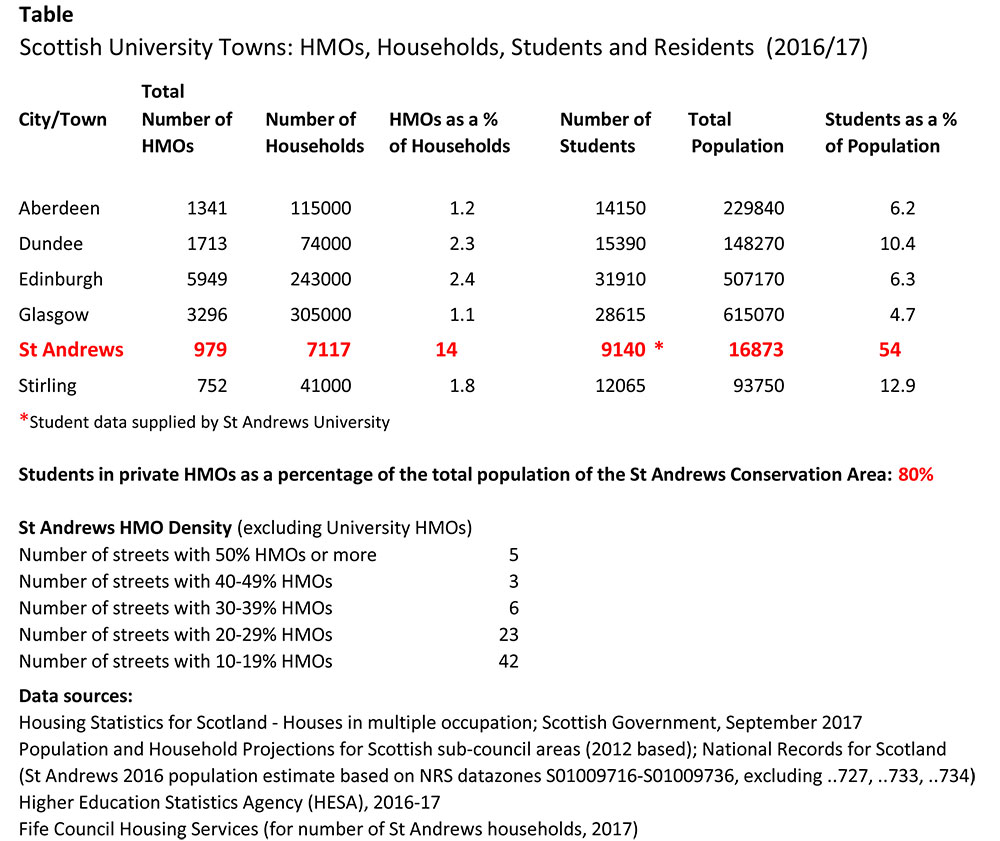In 1985, the student population in St Andrews was about 3,500. In 2018, it exceeded 9,000 and is set to rise further. In the intervening period, the total population has barely grown while the number of permanent residents has declined to the point at which they constitute a minority of the town’s population.
The total population of St Andrews is now approximately 17,000[1] and there is compelling evidence that the student population living in the town has increased at the expense of families and non-students who have been priced out of the market due to the upward pressure on house prices from buy-to-let investors. As a result, there has been a hollowing out of the town, best exemplified by the steep reduction in the proportion of children and the closure of a primary school.
While the creation of HMOs has been concentrated in and around the Conservation Area, where tenants of such properties can account for 80% or more of the population, there has been a steady expansion into adjacent areas. In addition to the conversion of properties that would have provided affordable family homes to HMOs in the private sector, many former local authority and housing association houses, coming on to the market via “Right to Buy”, have been lost to HMOs.
It is estimated that there has been a loss of more than 160 former council / housing association houses since the inception of mandatory HMO licensing while less than thirty have been built in this period. (Currently there are some 370 on the Council’s waiting list for social housing in St Andrews[2]. There is no shortage of University accommodation – in 2017 the University had 46 vacancies in its halls of residence and its building programme will provide a further 1000 spaces by 2020.
Additionally, there is under utilised private purpose-built student accommodation in the town – and more is planned. The loss of social as well as private family housing continues because there is no Housing Policy to regulate HMOs, and there is now an urgency to put such a policy in place if St Andrews is to survive as a mixed sustainable community. The continuing net loss of so much social housing in the context of a policy to increase this provision in an area of Housing Pressure makes no sense.
Other Issues
It has been claimed that limiting the number of HMOs would encourage landlords to close off bedrooms so as to avoid the necessity of an HMO licence and that two-bedroom student properties are not subject to the same level of regulation as HMOs, the inference being that they are less safe. No evidence has been produced to suggest that locked bedrooms are a feature of the rental market in St Andrews nor is there any evidence that two-bedroom flats are less safe than HMOs.
HMO licensing was introduced because of concerns about the safety of properties comprising multiple bedsits where the risk of fire was estimated[3] to be some six times that of smaller properties, such as two bed flats. Additional safety measures incorporated into statutory guidance in 2016 [4] and the Letting Agents Code of Practice (2016), which came into force in January 2018[5], have ensured that all types of rental properties are now subject to high safety standards, whether HMOs or not.
In relation to diverse housing provision, two-bed flats have the advantage of being part of the wider market, which includes non-students who are much more likely to rent such flats rather than HMOs, which are the preserve of the student market.
Overprovision Policies
Following amendments to the Housing (Scotland) Act 2006, made in 2011 [Amendments to Housing (Scotland) Act 2006] and Scottish Government guidance issued in 2012 [Scottish Government circular 2012] local authorities have had the ability to restrict new licences for Houses in Multiple Occupation where they consider there is overprovision. The present moratorium for the St Andrews Central Conservation Area is an example of the use of Planning policy (reflected in Policy 2, Fife Plan) to restrict the number of HMOs. However, an overprovision policy based on planning legislation can only cover situations where there are over two unrelated people in a flat and over 5 in a house, which means that most houses are exempt from any restriction. It is primarily for this reason that HMO numbers have continued to rise in the Central Conservation Area in spite of a moratorium being in place
Town Commission on Housing
In 2012, a group of local organisations resolved to promote a serious study of the housing situation in the town. To carry out this task, they established the ‘St Andrews Town Commission on Housing’ with involvement of local organisations, town residents, the University, Fife Council and a variety of housing providers as a forum for reconciling differences and for the advancement of housing development in St Andrews. From analysis of all the information and evidence, it recommended:
(i) that Fife Council examine the specific housing needs of St Andrews and develop a strategy for housing in the town;
(ii) that Fife Council, in collaboration with the St Andrews community, address the immediate need for affordable accommodation and actively pursue the building of affordable houses on the Kilrymont site of Madras College when it becomes available, and develop this site in tandem with the extant proposals for the development of St Andrews West;
(iii) that Fife Council determine, in collaboration with the St Andrews community, an appropriate yardstick for student housing density and, meantime, give serious consideration to extending the HMO moratorium geographically to embrace the whole town and to imposing restrictions on the renewal of HMO licences;
(iv) that the private provision of student ‘halls’ of residence be supported, and that the University actively promote the building of additional University-managed student accommodation, both undergraduate and postgraduate;
(v) that a ‘Standing Working Party’ be created comprising community representatives, the
Fife Council Housing Services Proposals
In spite of being a partner in the Town Commission on Housing, Fife Council Housing Services commissioned in 2016 an ‘Independent Review of Houses in Multiple Occupation’ by North Star Consulting and Research [North Star Final Report 14.11.16], following which it brought forward in 2017 a proposal to introduce a Housing Policy which seeks to manage concentrations of HMOs by placing limits on such establishments in areas where there is already overprovision is welcome since it will cover all HMOs, flats and houses. Hitherto, no such policy has been introduced in Fife, although over-provision policies are in operation in Dundee, Glasgow and Stirling which have much lower densities of HMOs (1.1%-2.3%) than St Andrews (14.9%).

Housing Services Option: No change in current levels of housing stock licensed as HMOs
The proposed option of no change in the current percentages of housing stock used as HMOs, quoted as 17%, 5% and 3% in Zones 1, 2, 3 respectively, would in fact represent an increase of 13 HMOs across Zones 1 and 3 since the percentages have been rounded up from 16.66% and 2.74% respectively.
Housing Services Option: 3% increase in housing stock converted to HMOs across all zones
This proposal is for a 3% increase in the number of homes that can be converted into HMOs, not a 3% increase in the number of HMOs, and would lead to an additional 212 HMOs (over and above the increase due to rounding up of the HMO percentages in Zones 1 and 3). Together, the total (225) represents an increase of 35% in non-university HMOs, with an equivalent loss of homes. Assuming an occupancy of 2 per property (the Scottish average) the loss of the family homes resulting from a 3% increase in the thresholds would potentially lead to a loss of 400-450 residents, reducing the resident population by a further 6% and taking it under 7000 for the first time since the mid -1800s. This loss will not be compensated for by the low level of new house building in St Andrews.
Conclusions
The North Star Report [North Star Final Report 14.11.16] acknowledged the upward pressure on house prices due to their value as HMO investments and, quoted in Fife Council’s review of planning guidance re HMOs (2014, p46), the agents Pagan Osborne reported that ‘central flats deprived of the ability to achieve HMO licences due to the moratorium can expect to realise between £50,000 – £80,000 less than similar properties with HMO licences’. It follows that when properties coming on to the market no longer attract the premium of a potential HMO, prices will fall and become more affordable for families.
Students justifiably demand good quality affordable accommodation during their stay in St Andrews but this should be not at the expense of a further loss of family homes. Since there is no demonstrable need for further HMOs, but there is a need for affordable homes, HMO thresholds should remain at current levels and any future expansion in student numbers should be accompanied by an equivalent volume of purpose-built student accommodation. Only by adopting such a policy is there any hope of St Andrews retaining any semblance of a mixed sustainable community.
Notes
[1] National Records of Scotland: 2015 population estimate for the town of St Andrews, based on the 2011 Census. [2] Fife Council; FOI request response January 15, 2018. [3] Department for Communities and Local Government, Evidence Gathering – Housing in Multiple Occupation and possible planning responses: Final Report (2008); Universities UK, ‘Studentification’: A Guide to Opportunities, Challenges and Practices (2006). [4] Housing (Scotland) Act 2006: Scottish Government Guidance on Satisfactory Provision for Detecting and Warning of Fires; November 2016. [5] The Letting Agent Code of Practice (Scotland) Regulations 2016.


1 comment